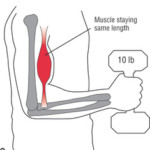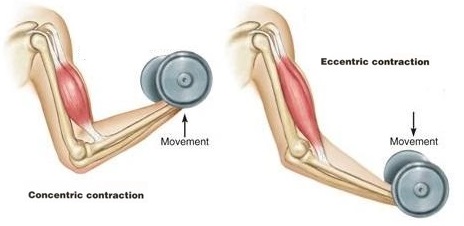There are three (3) different types of muscle contraction: concentric, eccentric, and isometric. These different types of muscle contraction differ by way of their affect on muscle length. Often types of muscle contraction are broken up into 2 groups: isotonic and isometric. Isotonic contractions are those that produce movement, while isometric does not.
The most common types of muscle contraction people think of when thinking about muscle is the concentric and eccentric contraction. A concentric muscular contraction is when the muscle exerts a force and shortens in length. An example of this is when the biceps contracts causing flexion to occur at the elbow. During this movement the biceps is producing the force (contracting) and also shortens in its length.
The opposite type of muscle contraction is eccentric contraction. Eccentric contraction is when the muscle produces a force but increases in its length. If we continue to think about the biceps at the elbow, an eccentric contraction would be when the elbow is extended from a flexed position, especially when carrying a weight. Here the biceps still has to produce a force to control the movement as the elbow extends, if it doesn’t produce a force the arm and weight will drop quickly under the force of gravity and may cause an injury.
 The final type of muscle contraction is the isometric contraction. An isometric contraction is when a muscle produces a force but does not change in length. Examples of isometric contraction would be to hold the weight at 90 degrees at the elbow or to hold a plank position. In the elbow at 90 degree position the biceps is still producing a force against gravity, but it is not changing in length. For the plank, the abdominal and other core muscles are producing a force against gravity while not changing their length, therefore they are isometric contractions.
The final type of muscle contraction is the isometric contraction. An isometric contraction is when a muscle produces a force but does not change in length. Examples of isometric contraction would be to hold the weight at 90 degrees at the elbow or to hold a plank position. In the elbow at 90 degree position the biceps is still producing a force against gravity, but it is not changing in length. For the plank, the abdominal and other core muscles are producing a force against gravity while not changing their length, therefore they are isometric contractions.
 The final type of muscle contraction is the isometric contraction. An isometric contraction is when a muscle produces a force but does not change in length. Examples of isometric contraction would be to hold the weight at 90 degrees at the elbow or to hold a plank position. In the elbow at 90 degree position the biceps is still producing a force against gravity, but it is not changing in length. For the plank, the abdominal and other core muscles are producing a force against gravity while not changing their length, therefore they are isometric contractions.
The final type of muscle contraction is the isometric contraction. An isometric contraction is when a muscle produces a force but does not change in length. Examples of isometric contraction would be to hold the weight at 90 degrees at the elbow or to hold a plank position. In the elbow at 90 degree position the biceps is still producing a force against gravity, but it is not changing in length. For the plank, the abdominal and other core muscles are producing a force against gravity while not changing their length, therefore they are isometric contractions. 

